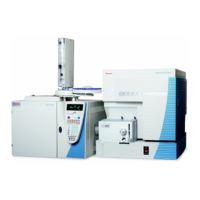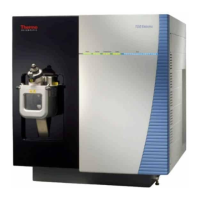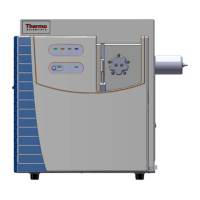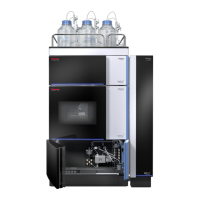2
Functional Description
Liquid Chromatograph
Thermo Scientific TSQ Series Hardware Manual 15
For front-panel (keypad) operation (if any) and maintenance procedures, refer to the
documentation provided with the autosampler.
Liquid Chromatograph
The (optional) liquid chromatograph (LC) separates a sample mixture into its chemical
components by liquid chromatography. In liquid chromatography, the sample mixture
partitions between a solid stationary phase of large surface area and a liquid mobile phase that
percolates over the stationary phase. The molecular structure of each component of the
mixture determines in which order each component elutes from the LC and enters the mass
spectrometer.
You can control most LCs and the corresponding UV detectors directly from the TSQ data
system computer. You can set the flow rate from 0 to 1000 μL/min or more. Refer to the
TSQ Series Getting Connected Guide for information on connecting an LC to the TSQ mass
spectrometer.
You configure the LC from the data system computer. Select the appropriate LC button in the
Instrument Configuration window, which is available by choosing Start > All Programs >
Thermo Foundation > Instrument Configuration. See Instrument Configuration Help for
a description of LC configuration options, refer to Xcalibur Help.
You also use the data system to set up the LC. Choose Start > All Programs >
Thermo Xcalibur > Xcalibur and click Instrument Setup to open the Instrument Setup
window. Then, click the appropriate LC icon to open the LC page. For instructions on
running your LC, refer to the Help.
If your LC is controlled from a Thermo Scientific data system, refer to the interconnect
diagrams in Figure 33 on page 47 and Figure 34 on page 48, and the Getting Connected Guide
for the LC, for information on connecting the LC to the data system computer.
For front-panel (keypad) operation (if any) and maintenance procedures, refer to the
documentation provided with the LC.
Syringe Pump
The TSQ mass spectrometer includes an electronically-controlled, integrated syringe pump.
See Figure 6. The syringe pump delivers sample solution from the syringe into the
atmospheric pressure ionization (API) source. When the syringe pump is operating, a motor
drives a pusher block that depresses the plunger of the syringe at a rate of one percent of the
syringe volume per minute. Liquid flows out of the syringe needle and into the sample
transfer line as the plunger is depressed. A syringe holder holds the syringe in place. Refer to
the TSQ Series Getting Started Guide or the TSQ Series Getting Connected Guide for
instructions on setting up the syringe pump.

